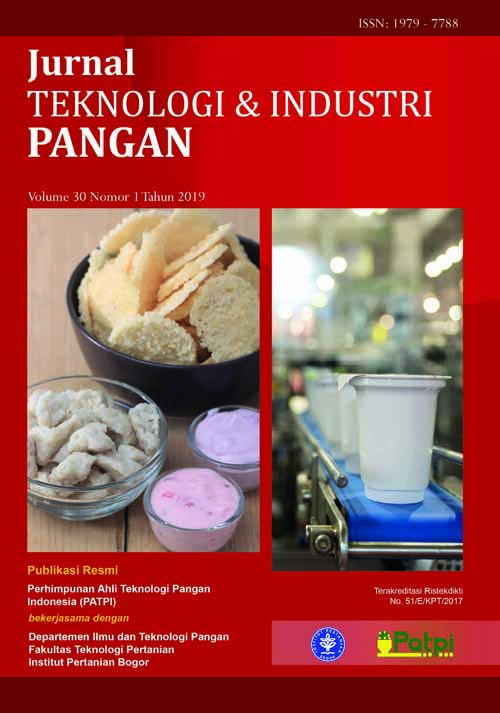MODULATION OF PHENOLICS SUBSTANCES AND ANTIOXIDANT ACTIVITY IN MANDAI CEMPEDAK BY UNSALTED SPONTANEOUS AND Lactobacillus casei INDUCED FERMENTATION
Abstract
Cempedak (Artocarpus champeden) is a tropical fruit whose inner-skin contains high polyphenolic-based antioxidant. Traditionally, the inner-skin is soaked in brine to induce spontaneous lactic acid bacte-ria (LAB) fermentation. This research aimed to investigate the changes of polyphenolics substances and antioxidant activity during the course of spontaneous and Lactobacillus casei induced fermented at opti-mum (37°C) and sub-optimum (8°C) temperatures. Phenolic substances were spectrophotometrically measured with gallic acid (GAE), tannic acid (TAE), and catechin (CE) as the standards for the respective groups. The 50% maximum inhibitory concentration (IC50) for DPPH reduction was measured. A thin layer chromatography (TLC) using different solvents was utilized to qualitatively show differences of substances extracted from the unfermented and fermented mandai cempedak. The retention factor (Rf) values for TLC spots were measured after the plates were exposed under 366 and 254 nm of UV lamp. Fermentation increased phenolic substances release from the inner skin of cempedak which positively modulated the potential antioxidant activity. Sub-optimum temperature fermentation reduced total phenolic-based antioxidant. Ethyl acetate or combinations of n-hexane and ethyl acetate gave better separation in TLC plate. Differences in stain patterns were exhibited by mandai cempedak before and after L. casei induced fermentation. In summary, L. casei induced fermentation was more effective at optimum temperature to increase phytochemical substances of mandai cempedak, while spontaneous fermentation showed to be more effective after 11 and 13 days at sub-optimum temperature.
References
Bakar MFA, Karim FA, Perisamy E. 2015. Compa-rison of phytochemicals and antioxidant proper-ties of different fruit parts of selected Artocarpus species from Sabah, Malaysia. Sains Malaysia-na 44: 355-363. DOI: 10.17576/jsm-2015-4403-06.
Bakar MFA, Karim FA, Perisamy E. 2015. Compari-son of phytochemicals and antioxidant proper-ties of different fruit parts of selected Artocarpus species from Sabah, Malaysia. Sains Malaysia-na 44: 355-363. DOI: 10.17576/jsm-2015-4403-06
Banu I, Vasilean I, Aprodu I. 2010. Effect of lactic fermentation on antioxidant capacity of Rye Sourdough and Bread. Food Technol Res 16: 571-576. DOI: 10.3136/fstr.16.571.
Curiel JA, Pinto D, Marzani B, Filannino P, Farris GA. 2015. Lactic acid fermentation as a tool to enhance the antioxidant properties of Myrtus communis Berries. Microb Cell Fact 14: 67. DOI: 10.1186/s12934-015-0250-4.
Dajanta K, Janpum P, Leksing W. 2013. Antioxidant capacities, total phenolics and flavonoids in black and yellow soybeans fermented by Bacil-lus subtilis: A comparative study of Thai fer-mented soybeans (Thua nao). Int Food Res J 20: 3125-3132.
Emmawati A, Laksmi BS, Nuraida L, Syah D. 2015. Karakterisasi isolat bakteri asam laktat dari mandai yang berpotensi sebagai probiotik. Agritech 35: 146-155. DOI: 10.22146/agritech.9 400.
Farhan H, Rammal H, Hijazi A, Hamad H, Daher A, Reda M, Badran B. 2012. In vitro antioxidant activity of ethanolic and aqueous extracts from crude Malva parviflora L. grown in Lebanon. Asian J Pharm Clin Res 5: 234-238.
Hanani E. 2014. Analisis Fitokimia. 227-229. EGC Penerbit Buku Kedokteran. Jakarta. Indonesia.
Kusumowati ITD, Sudjono TA, Suhendi A, Da’i M, Wirawati R. 2012. Korelasi kandungan fenolik dan aktivitas antiradikal ekstrak etanol daun empat tanaman obat Indonesia (Piper bettle, Sauropus androgynus, Averrhoa bilimbi, dan Guazuma ulmifolia). Pharmacon 13: 1-5.
Li X, Wu X, Huang L. 2009. Correlation between an-tioxidant activities and phenolic contents of ra-dix Angelicae sinensis (Danggui). Molecules 14: 5349-5361. DOI: 10.3390/molecules14125349.
Liu Y, Friesen JB, Grzelak EM, Fan Q, Tang T, Durić K, Jaki BU, McAlpine JB, Franzblau SG, Chen SN, Pauli GF. 2017. Sweet spot matching: A thin-layer chromatography-based countercur-rent solvent system selection strategy. J Chro-matogr A 1504: 46-54. DOI: 10.1016/j.chroma. 2017.04.055.
Malangngi LP, Sangi MS, Paedong JJE. 2012. Pe-nentuan kandungan tanin dan uji aktivitas anti-oksidan ekstrak biji buah alpukat (Persea ame-ricana Mill.). J Mipa Unsrat Online 1: 5-10.
Mu’nisa A, Wresdiyati T, Kusumorini N, Manalu W. 2012. Aktivitas antioksidan ekstrak daun ceng-keh. J Veteriner 13: 272-277.
Nazarni R, Purnama D, Umar S, Eni H. 2016. The effect of fermentation on total phenolic, flavor-noid and tannin content and its relation to anti-bacterial activity in jaruk tigarun (Crataeva nur-vala, Buch HAM). Int Food Res J 23: 309-315.
Nur HS. 2009. Suksesi mikroba dan aspek biokimia-wi fermentasi mandai dengan kadar garam ren-dah. Makara Sains 13: 13-16. DOI: 10.7454/ms s.v13i1.350.
Nurhayati, Siadi K, Harjono. 2012. Pengaruh kon-sentrasi natrium benzoat dan lama penyimpan-an pada kadar fenolat total pasta tomat. Indo J Chem Sci 1: 158-163.
Park E, Kim H, Eom SJ, Paik H. 2015. Antioxidative and anticanceric activities of Magnolia (Magno-lia denudata) flower petal extract fermented by Pediococcus acidilactici KCCM 11614. Mole-cules 20: 12154-12165. DOI: 10.3390/molecu les200712154.
Perwiratami C, Suzery M, Cahyono B. 2014. Korela-si fenolat total dan flavonoid total dengan anti-oksidan dari beberapa sediaan ekstrak buah tanjung (Mimusops elengi). Chem Progr 7: 34-39.
Rahmadi A, Abdiah I, Sukarno MD, Purnaningsih T. 2013. Karakteristik fisikokimia dan antibakteri virgin coconut oil hasil fermentasi bakteri asam laktat. J Teknol Industri Pangan 24:178-183. DOI: 10.6066/jtip.2013.24.2.178.
Rahmadi A, Sabarina Y, Agustin S. 2018. Different drying temperatures modulate chemical and an-tioxidant properties of mandai cempedak (Arto-carpus integer). F1000Res 7: 1706. DOI: 10.12 688/f1000research.16617.1.
Rahmadi A, Sari K, Sitohang S, Khoiriyah N, Handa-yani F, Emmawati A, Yuliani. 2017. Profil per-ubahan populasi BAL, pH, kadar flavonoid, dan potensi aktivitas antioksidan dari fermentasi mandai cempedak higienis tanpa garam. Prosi-ding Seminar Nasional PATPI 10-12 Oktober 2017, Bandar Lampung, Lampung.
Rhee SJ, Lee JE, Lee CH. 2011. Importance of lactid acid bacteria in asian fermented foods. Microb Cell Fact 10: 1-13. DOI:
1186/1475-2859-10-S1-S5.
Valerio F, Di Biase M, Lattanzio VMT, Lavermicocca P. 2016. Improvement of the antifungal activity of lactic acid bacteria by addition to the growth medium of phenylpyruvic acid, a precursor of phenyllactic acid. Int J Food Microbiol 222: 1-7. DOI: 10.1016/j.ijfoodmicro.2016.01.011.
Zou Y, Lu Y, Wei D. 2004. Antioxidant activity of fla-vonoid rich Extract of Hypericum pertoratum L. in vitro. J Agric Food Chem 52: 5032-5039. DOI: 10.1021/jf049571r.

